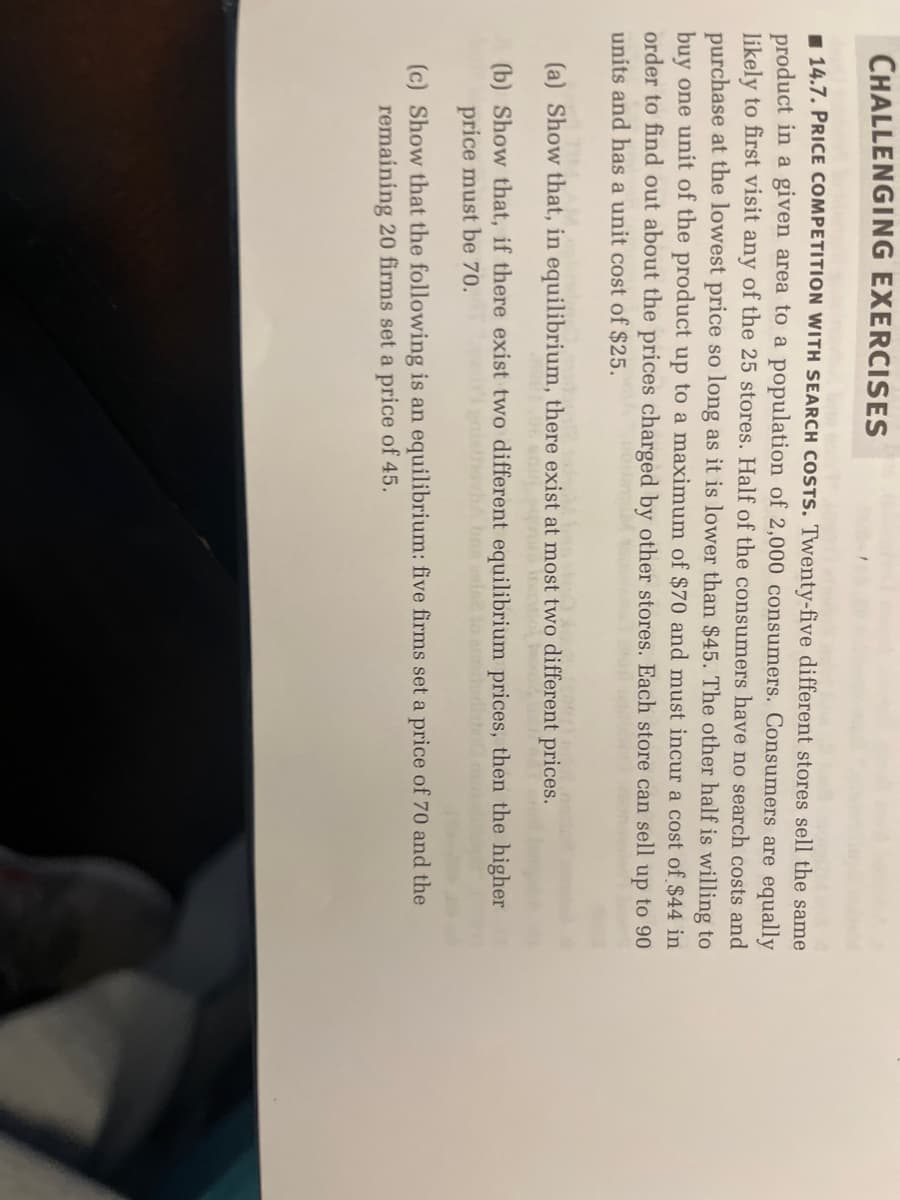CHALLENGING EXERCISES 14.7. PRICE COMPETITION WITH SEARCH COSTS. Twenty-five different stores sell the same product in a given area to a population of 2,000 consumers. Consumers are equally likely to first visit any of the 25 stores. Half of the consumers have no search costs and purchase at the lowest price so long as it is lower than $45. The other half is willing to buy one unit of the product up to a maximum of $70 and must incur a cost of $44 in order to find out about the prices charged by other stores. Each store can sell up to 90 units and has a unit cost of $25. (a) Show that, in equilibrium, there exist at most two different prices. (b) Show that, if there exist two different equilibrium prices, then the higher price must be 70. gaistrovhA bas and to add (c) Show that the following is an equilibrium: five firms set a price of 70 and the remaining 20 firms set a price of 45.
CHALLENGING EXERCISES 14.7. PRICE COMPETITION WITH SEARCH COSTS. Twenty-five different stores sell the same product in a given area to a population of 2,000 consumers. Consumers are equally likely to first visit any of the 25 stores. Half of the consumers have no search costs and purchase at the lowest price so long as it is lower than $45. The other half is willing to buy one unit of the product up to a maximum of $70 and must incur a cost of $44 in order to find out about the prices charged by other stores. Each store can sell up to 90 units and has a unit cost of $25. (a) Show that, in equilibrium, there exist at most two different prices. (b) Show that, if there exist two different equilibrium prices, then the higher price must be 70. gaistrovhA bas and to add (c) Show that the following is an equilibrium: five firms set a price of 70 and the remaining 20 firms set a price of 45.
Managerial Economics: A Problem Solving Approach
5th Edition
ISBN:9781337106665
Author:Luke M. Froeb, Brian T. McCann, Michael R. Ward, Mike Shor
Publisher:Luke M. Froeb, Brian T. McCann, Michael R. Ward, Mike Shor
Chapter23: Managing Vertical Relationships
Section: Chapter Questions
Problem 1MC
Related questions
Question

Transcribed Image Text:CHALLENGING EXERCISES
14.7. PRICE COMPETITION WITH SEARCH COSTS. Twenty-five different stores sell the same
product in a given area to a population of 2,000 consumers. Consumers are equally
likely to first visit any of the 25 stores. Half of the consumers have no search costs and
purchase at the lowest price so long as it is lower than $45. The other half is willing to
buy one unit of the product up to a maximum of $70 and must incur a cost of $44 in
order to find out about the prices charged by other stores. Each store can sell up to 90
units and has a unit cost of $25.
(a) Show that, in equilibrium, there exist at most two different prices.
(b) Show that, if there exist two different equilibrium prices, then the higher
price must be 70.
(c) Show that the following is an equilibrium: five firms set a price of 70 and the
remaining 20 firms set a price of 45.
Expert Solution
This question has been solved!
Explore an expertly crafted, step-by-step solution for a thorough understanding of key concepts.
Step by step
Solved in 5 steps

Knowledge Booster
Learn more about
Need a deep-dive on the concept behind this application? Look no further. Learn more about this topic, economics and related others by exploring similar questions and additional content below.Recommended textbooks for you

Managerial Economics: A Problem Solving Approach
Economics
ISBN:
9781337106665
Author:
Luke M. Froeb, Brian T. McCann, Michael R. Ward, Mike Shor
Publisher:
Cengage Learning

Managerial Economics: Applications, Strategies an…
Economics
ISBN:
9781305506381
Author:
James R. McGuigan, R. Charles Moyer, Frederick H.deB. Harris
Publisher:
Cengage Learning


Managerial Economics: A Problem Solving Approach
Economics
ISBN:
9781337106665
Author:
Luke M. Froeb, Brian T. McCann, Michael R. Ward, Mike Shor
Publisher:
Cengage Learning

Managerial Economics: Applications, Strategies an…
Economics
ISBN:
9781305506381
Author:
James R. McGuigan, R. Charles Moyer, Frederick H.deB. Harris
Publisher:
Cengage Learning

